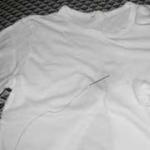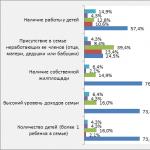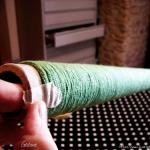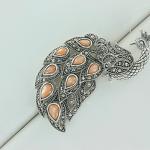Labor education in the middle group is a useful and exciting activity. Notes on organizing collective work Topic: “Let's teach Masha to work” middle group Notes on collective work in the middle group
Card index: Household work in middle group.
Card number 1.
“Order in the closet with toys and manuals”
Target : teach children to independently and aesthetically arrange toys and aids, maintain order in closets, wipe dust. Develop hard work and the ability to see disorder. Bring up aesthetic taste, desire to work for the benefit of others.
Card number 2.
"Clean window sills"
Target : teach children to observe hygienic rules when working with water skills : roll up your sleeves, wet a cloth and wring it dry, rinse as it gets dirty. Develop labor skills and habits, accuracy when working with water. Cultivate a desire to work in a team, in harmony.
Card number 3.
"Helping the nanny"
Target : Learn to make bed linen and teach children to provide all possible assistance to adults. Develop hard work and a desire to help adults. Cultivate respect for the work of adults.
Card number 4.
"Dining duty"
Target : independently and conscientiously perform the duties of a duty officer; wash your hands thoroughly, put on the clothes of the person on duty, set the table correctly, remove the dishes after eating; brush off tables and sweep the floor. Develop work skills andskills, the ability to see disorder in the table setting. Cultivate a desire to work for the benefit of others.
Card number 5.
"Class Duty"
Target : independently and conscientiously perform the duties of the duty officer: lay out on the tables materials and manuals prepared by the teacher for the lesson; wash and put them away after class. Develop hard work and a desire to help adults. Foster a desire to work for the benefit of others.
Card number 6.
"Order in toys"
Target : teach children to put on work aprons before starting work; keep toys in order: wash, dry, wipe and put in place. Develop hard work and the ability to see disorder; be careful when working with water. Foster a desire to work for the benefit of others X .
Card number 7.
“Order in the dressing room closet(together with an assistant teacher)»
Target : teach children to keep their personal closets in order clothes : empty the closet of clothes and shoes, wipe the shelves with a damp cloth, and carefully put the clothes back in place. Develop diligence, the ability to see disorder, and accuracy when working with water. Cultivate a desire to work in a team, in harmony.
Card number 8.
"Book Repair"
Target : teach children to peck at books, use glue and scissors correctly, and use napkins.
Develop labor skills, eye, fine motor skills hands, creative imagination. Cultivate desire T work for the benefit of others, treat books and toys with care.
Card number 9.
"Clean chairs"
Target : teach children to help keep chairs tidy and clean V group room: wipe them with a damp cloth; arrange in places after classes. Developlabor skills and abilities, the ability to comply with cultural and hygienic requirements when working. Cultivate a desire to help adults, respect for them labor
Card number 10.
"Washing Doll Clothes"
Target : Teach children to help the teacher in washing doll clothes and beds : teach children to put on work aprons before starting work; prepare the necessary supplies for washing and drying, as well as a workplace; know how to use soap. Develop labor skills and abilities, the ability to comply with cultural and hygienic requirements when working. Cultivate a desire to work for the benefit of others.
Card number 11.
"Washing my combs"
Target : Teach children to help the teacher in washing the calculation juice : rinse soaked combs, clean them with brushes. Develop diligence, the ability to see disorder, and accuracy when working with water.
Foster a desire to help adults and respect for their work.
Fedora: - I didn’t like to work: washing dishes and floors, tidying up all my things. Now the trouble has happened... Educator: -Who are these guys? Children: - Fedora. V. - From what fairy tale did Fedora come to us? Children: - Fedorino's grief. V. - That's right, who wrote this fairy tale? Children: - Korney Ivanovich Chukovsky. Fedora: - Hello, guys. Educator: - Hello, Fedora, why didn’t you wash the dishes, wash your things or tidy up, that means you were lazy. Guys, is it good to be lazy? Children: - No.
View document contents
“Socially useful work in the middle group. “How we taught Fyodor to work.”
Abstract open class for household work in the middle group
“How we taught Fyodor to work.”
Target: formation of a positive attitude towards work and its results.
Tasks:
1. Teach children to participate in the organized work of a group of peers, to correlate their activities with the work of others and to understand that the work of the subgroup in which you work is part of the common cause of the team.
2. Improve labor skills and abilities in the work process, improve the ability to plan your activities, distribute responsibilities among yourself, evaluate the work of your group and the team as a whole.
3. Strengthen the ability to correctly use materials and work equipment, observing safety precautions.
4. To form a belief in the social significance and necessity of domestic work.
5. Cultivate friendly relationships during the work process, a desire to help, a positive attitude towards one’s own work and the work of one’s peers.
Methods and techniques: conversation, explanation, problematic questions, clarification, literary expression, reliance on children’s knowledge, practical work, surprise moment.
Location: group.
Materials and equipment: sponges, aprons, soapy and clean water, trays, oilcloths, basins, tables; a set of building materials, toys, clothes and underwear for dolls.
Preliminary work: conversation about work, memorizing proverbs and sayings about work, reading poems and fairy tales, looking at illustrations and albums about various professions of adults, consolidating ideas about work through didactic games.
Predicted result: as a result of collective household work, children have formed a value-based attitude towards their own work and the work of their peers; children should understand that after their work the group became clean, light and beautiful.
Progress of the lesson:
I. Organizational moment.
Educator: -Who is it that is crying here? What's happened? What a disaster! Everything she had ran away from Fedora: dishes, clothes, and toys. It's true! And where did it all go? Everything has disappeared! Why?
Fedora: - I didn’t like to work: washing dishes and floors, tidying up all my things. Now the trouble has happened...
Educator: -Who are these guys?
Children: - Fedora.
V. - From what fairy tale did Fedora come to us?
Children: - Fedorino's grief.
V. - That's right, who wrote this fairy tale?
Children: - Korney Ivanovich Chukovsky.
Fedora: - Hello, guys.
Educator: - Hello, Fedora, why didn’t you wash the dishes, wash your things or tidy up, that means you were lazy. Guys, is it good to be lazy?
Children: - No.
Fedora: - Help me, guys, wash and wash everything. I won’t forget you, I’ll invite you to visit, I’ll play with you, I’ll show you a fairy tale.
Educator: -Children, let's help Fedora, bring cleanliness and order to the group, and at the same time teach her how to work. Let's go through the group and see what needs to be done to ensure that everything is in order in the group. Children determine the subject of labor: wipe the building material, wash the toys, clean up the doll's corner.
Educator:- When they work together, it is necessary to distribute the work and decide together the question of who will do what, so think and say who will do what work. Well, Fedora, don’t be lazy, but work hard with us.
The teacher helps to assign foremen and children who will work where.
Educator:-Guys, to clean up, what do we need for this (what equipment)?
Children:- Basins with clean and soapy water, sponges, rags, soap, aprons.
But before we start working, let’s together remember the rules for safe handling of work items.
Rules:
Do everything you can yourself;
Don't forget to clean up after yourself;
Respect other people's work;
Before you start working, prepare everything you need;
Do everything carefully, without rushing;
Don't leave work unfinished;
If you finished the job earlier, help others.
Physical exercise “Fingers say hello.”
Educator: Well, now let’s put on our aprons and get to work!
Children go to their work stations, put on aprons, help each other, and dismantle the equipment. The teacher pours pre-prepared water into basins
During the work process, the teacher gives advice, helps in organization, reminds the work procedure; asks how the children divided up work responsibilities and provides individual assistance
Educator: Well done, what wonderful and hardworking children, and now let’s not forget to clean up our desk, put everything back in its place, and take off our aprons.
The teacher makes sure that after completing work, the children clean up their work areas and put all materials and equipment back in their place. Invites children to sit on chairs. Then he invites you to admire the results of your labor.
Analysis labor activity in subgroups
Now, Fedora, look and evaluate the work.
Have you done everything yet?
Did you work together?
Did you finish the job you started?
Has your mood changed?
This is because you love to work! And work brings joy. IN working together friendship is born.
Educator: Each of you did your own little thing, but together you did a big thing. This is how clean and beautiful the group is now, because cleanliness is the key to health.
Fedora:- Thank you for teaching me and helping me bring order to the group. Now I will always work too, it’s so interesting! I will keep my play area clean and tidy.
Educator:- What do you think, after we have all worked together, what proverbs can be used to sum up our work?
Children's answers: Business before pleasure; Time for business is time for fun.
Summary of collective work cleaning play corners in the middle group “Labour lesson for Lenivitsa”
Target: Clean up the play areas.
Program content: Continue to train children in the correct use of cleaning equipment (cloths for wiping dust), wiping off dust; cultivate interest in work and desire to work; develop basic work skills.
Preliminary work: Observing the work of an assistant teacher, talking about the need for work for the common good. Reading fiction“Fedorino’s grief”, watching the cartoon “Moroz Ivanovich”.
Teacher training: Reading methodological literature, planning the sequence of work.
Equipment: Inventory: aprons according to the number of children, rags 30x30 cm, 2 basins with warm water.
Progress of collective work :
Educator: Guys, come to me.
Children approach the teacher. There is a knock on the door. Two girls (pod.gr.) dressed in Russian sundresses enter.
1 girl: Hello guys!
Children: Hello!
1 girl: We are girls from the fairy tale “Moroz Ivanovich”. My name is the Needlewoman, and this is my sister – Sloth. Our mother's birthday is coming soon, and we want to please our mother - so that the hut is clean. But my little sister doesn’t know how to wipe dust from the shelves in the closet or wipe the dust from toys. Will you guys help us, teach Sloth?
Children: Yes, we will help.
Needlewoman: Guys, do you know how to wipe off dust?
Children: Yes, we can.
Needlewoman: What do you need to wipe off the dust?
Children: Water and rags.
Educator: That's right, guys! We have all this. And water and rags and aprons. And now the children will teach Lenivitsa to wipe the dust on the shelves, wipe the toys and put them back in their place. Yes guys?
Children: Yes, we will teach you.
Educator: Guys, we will now divide into two groups. Let's put on aprons, roll up our sleeves so as not to wet our clothes, and take some rags. One group will wipe with the Needlewoman rubber toys, and another group will teach Sloth to wipe dust on the shelves.
Needlewoman: And Lenivitsa and I will help the guys put on aprons.
Educator: Guys, to prevent water from dripping from a rag onto the floor, what should you do?
Children: Wring out the cloth firmly.
Educator: Correct.
The teacher divides the children into two groups. Children, with the help of the Needlewoman and Sloth, put on aprons and begin to work.
As the children work, the teacher helps children in need with advice, reminds them of the need to put toys in their place and shows by personal example how to wring out a cloth firmly. The children finish their work.
Educator: Well done, guys! We managed to do everything.
Needlewoman: Yes! We did it all! We did everything! And my little sister Lenivitsa was taught to wipe the dust.
Lenivitsa: Yes, the guys taught me. Thank them very much. Now I can handle this work myself. I can do anything. Goodbye, guys.
Children: Goodbye.
Educator: Look, guys, how great you are. Everyone worked a little, and together you put things in order in our play corner. As the Russian proverb says, “It’s not difficult to be together, but even if you’re apart.” Look how clean and beautiful our place has become. All the toys smile at us. You all tried, worked together, helped each other, did everything right.
Well done everyone!
And now, as they say in Russian folk proverb" Business before pleasure".
You can now play or draw.
And the attendants will help me put all the rags in a basin and the aprons in a box.
Summary of collective work on care indoor plants in the older group.
Target: organize practical activities for children in nature by caring for indoor plants in a corner of nature.
Tasks:
- Instill in children a desire to work;
- Continue to teach how to care for indoor plants;
- Develop observation and curiosity in children;
- Foster a careful and caring attitude towards nature.
Form of organization: collective work.
Type of work: labor in nature.
Equipment: 2 basins, rags according to the number of children, aprons according to the number of children, dry brushes, watering cans, sprayers, a mole toy.
Indoor plants: sansevieria, coleus, violet, balsam, ever-flowering begonia, birch, tradescantia.
Equipment preparation:
After afternoon tea, when the children have finished eating, I prepare the equipment: I ask the attendants to help me pour water into basins, prepare rags, bring watering cans, and get aprons.
Organization, content and methods of guiding the collective work of children in caring for indoor plants:
- Guys, today a mole came to visit us. But the mole came for a reason, he came on business. The mole decided to warn you and me and save our plants in the group.
- Listen to what the mole says!
- "Guys! Trouble! The evil wizard found out that we have a lot of beautiful plants in our group and decided to take them away from us! He sent his assistants - dust and dirt, so that they settled on the plants, and they dried up."
- Don’t be sad, mole, we will save our plants!
- Guys, let's drive these bad guys away!
But tell me, how will we fight our enemies?
- That's right, we will water our plants, wipe the large leaves with a cloth, wipe off the dust from the fleecy ones with a dry brush, and spray the small leaves.
- But guys, you and I need protective clothing to protect ourselves from these pests. What do you think will be our protective clothing?
- That's right, aprons. Let's put them on.
- Look, this is how we will wipe the large leaves of the sansevieria with a wet cloth. We take a cloth, wet it in a basin of water, then wring it out thoroughly and spread it on the palm of our hand. We support the sheet from below with one hand, and with the other we wipe the sheet from above, then from below. Like this.
- Carefully brush off the dust from the fleecy leaves of violets and coleus with a dry brush.
- We will spray plants with small leaves, such as balsam, evergreen begonia, birch and tradescantia.
- Is everything clear to everyone? Then we begin work to save our plants.
- Now everyone will go to their plant, water it, and then remove the evil dust from it.
- Don’t forget, guys, that we wring out rags well. Remove dust from large leaves with a damp cloth, brush off dust from fuzzy leaves with a dry brush, and spray on small leaves.
Analysis of children's activities:
- That's how great you all are! As hard as you try, you work together, you removed all the dust from the plants, now the evil wizard will never get to them! The mole thanks you, and now he’ll go and tell everyone how good, kind the kids are in our group, how they work together!
Equipment cleaning:
- Now the attendants will take the basins to the washroom, pour the water out of them and put them in place, and all the other guys will hang rags on the radiator, put the brushes in the box, the aprons in the cabinet, and fill the watering cans with water.
Summary of work organization in preparatory group. “Together we will restore order in the group”
Target: teach children to maintain order in a group, strengthen the ability to distribute teamwork and implement it together.
Tasks:
1. Develop the ability to plan the sequence of your work.
2. Perform the necessary work actions independently: prepare the place and equipment for work; improve the ability to wash toys, building materials, wipe dust on furniture, and clean up the book corner.
3. Cultivate accuracy, hard work, responsibility for the assigned work, mutual assistance, and a sense of satisfaction from the implementation of the work plan.
Equipment: basins, rags, aprons, tables.
Creating a play situation: toys in the group are not put away, some items are out of place.
The teacher and children are included in the group.
Educator: Children, why are we in such a mess here? We had everything in order this morning, what happened while we were away? Maybe some of you made such a bad joke? It's not you?
Carlson runs in: Here I am! I send greetings to everyone, friends!
Educator: Guys, who came to us?
Children: Carlson!
Educator: Carlson, so you put things in order here?
Carlson: Yes! Am I really great? Cleaned everything up in one minute?
Educator: Children, do you think there is order in our group? Beautiful? Cosy? Are the toys all clean and in place? (children's answers)
Carlson: You don’t understand anything! Disorder is best order! Beauty! Let's go and play!
Children: No, Carlson, time for business, time for fun! Before you leave, you need to put things in order and put everything in its place.
Carlson: You are so small and you know how to wash and clean everything yourself! (children's answers)
Carlson: Oh, and it’s probably boring for you to do this uninteresting thing...
Children: Not boring at all, but even interesting! The day until the evening is boring if there is nothing to do! Working hard will always come in handy. If you love to ride, you also love to carry sleds.
Educator: Why don’t you like to work?
Carlson: It's so tiring, boring, difficult... But I love fun!
Educator: Maybe you're just lazy?
Carlson: No. I just never tried to restore order and cleanliness.
Educator: Guys, let's teach Carlson how to put things in order and follow the rule “Every thing has its place”! Before you start cleaning in the group, you need to collect toys from the floor. When everything is scattered, you can accidentally step on a toy and break it or get injured. (children put toys back in place).
Educator: Guys, what do we need to wash the toys and wipe the dust off the shelves?
Children list: aprons, rags, basins with water.
Educator: Before work, we need to remember the labor rules that will help us get the job done quickly and efficiently.
Children: You cannot be distracted from work;
Any work must be completed to the end with high quality and accuracy;
Handle water carefully;
Finish what you started,
Help your friend if he is unable to cope with his work with advice or action;
Whoever finishes the work the fastest must help those whose work has not yet been completed; accept help with gratitude.
After work, you must clean your workplace.
Educator: Children, now let’s divide ourselves into units, choose the eldest and distribute who will do what kind of work.
Children put on aprons, roll up their sleeves, independently take the necessary equipment, and get to work.
Carlson approaches working children, asks what they do, how they do it, and tries to work himself.
At the end of their work activity, children clean their workplace and approach the teacher.
Educator: Children, what great fellows you all are! Look how clean, beautiful and cozy it has become in our group. Let's remember what we did for this? What were we doing?
Children list the types of work they performed.
Educator: Why do you think we did the work quickly?
Children: Everyone worked together, in harmony, and helped each other in their work.
Educator: You are correct. We have cleanliness and order in our group, because you worked without quarreling, quickly, efficiently, helping each other. It’s not for nothing that people say, “Patience and work will grind everything down!” ", "Friendly - not burdensome! »
Carlson: What wonderful, hardworking children! Thank you for teaching me and helping me bring order to the group. Now I will always work too, it’s so interesting. I will always support
cleanliness and order in your play area. Now can you play with me and have fun?
Educator: Carlson, don’t think about it, our children have as much fun as they work. Now they will play you a cheerful melody on wooden spoons.
Carlson: Well, I’ll listen with great pleasure. Now I also know the saying about work: “Time for work, time for fun!” »
Children play on spoons with musical accompaniment.
Carlson: Thank you guys for teaching me how to work. And now it's time for me to return home. See you again!
Prepared by: teacher Tishina Irina Andreevna Municipal budget preschool educational institution kindergarten general developmental type No. 10 "Herringbone" , Moscow region, Ozyory
Educational field: Social and communicative development.
Program goals and objectives:
- developing a child’s positive attitude towards work
- develop work skills and improve them
- develop skills in organizing the work process
- form friendly relations children to each other, teach to evaluate the activities of others, make comments.
Organization: subgroup. I put on aprons for the children and myself in advance, and prepare the subject-development environment.
Equipment: three basins with water, 5 rippers, a watering can with water, rags and aprons according to the number of children.
Progress of work.
Introductory part:
a) To focus children on the social significance of work and responsibility for its implementation - we will arrange a bath day for our group. And for this we need to wash the toys, tables and chairs, flowers.
I gather the children on the carpet.
A surprise moment: the doll Masha came to visit
Educator: Who came to us? What is your name? What are you doing in our group?
My name is Masha. I heard that today is your bath day. While you were sleeping, I decided to help you clean up, I cleaned almost everything.
Educator: Why are you so dirty? How did you clean up, nothing has changed in our group. Really, guys? (Truth)
Well, I wiped the dust off the table (wipes the table with his hand)
Educator: What are you talking about, who wipes the dust like that!
So how should it be? (asks the children)
With a napkin - the children answer.
Educator: How did you wipe the flowers?
Why wipe them, then? (blows on a flower), and everything is ready.
This is absolutely no good. The guys need to teach Masha how to clean properly. Sit down Masha and watch carefully, now the guys and I will teach you how to clean up properly.
b) Explanation and demonstration of how to perform:
Educator: Guys, let's remember how to wash toys?
How to wash the chairs? (wash the back, legs, seat).
How should you care for indoor plants? (wipe large leaves by carefully placing the leaf on your palm and wiping with the other hand) We do everything carefully and carefully!
c) Educator: We have a lot to do, and for this I will divide you into teams and choose the leaders. They will ensure that all tasks are completed and provide assistance.
(I specify the place of work of each link, what it will do; the emotional attitude towards responsible and high-quality performance.)
Check if you have everything you need to work.
Main part:
a) training in basic labor planning, i.e. teach children to organize their work:
Educator: Let's see what is needed for work?
teach children to plan tasks:
Where do we start? How will we do it? What will you do next? How? (if you need to clarify the actions).
teach managers to monitor and evaluate work:
What will you check?
How will you finish your work? (Target children, control that they check themselves during work and do not make mistakes).
Remind them to remember to put everything back in its place after work.
b) Techniques for managing the work of individual units of children:
Example of an adult, showing, reminding, encouraging, explaining; example of children, organization of mutual aid for children, note good deeds children, stimulate mutual assistance; bring the job started to completion; learn to work together and carefully.
c) Completion of the labor process: cleaning the workplace (leaders supervise the cleaning).
a) Summarize the work as a whole and by subgroups, note the importance of collective work;
b) Evaluation of the work of units and individual children: / evaluation is educational and encouraging. /
Educator: What did your unit do and how? Who worked hard? How and in what ways did you help each other?
- involve children in evaluating the work of another level (has everything been done, has the workplace been cleaned)
(fairness and friendliness of the assessment; we discuss in a tactful manner shortcomings in the work).
Well done boys! Masha has prepared riddles for you:
Dark night, clear day
He fights fire.
In a helmet, like a glorious warrior,
He's in a hurry to fight the fire. (firefighter).
He puts the bricks in a row,
Builds a kindergarten for the children
Not a miner or a driver,
He will build us a house. (builder)
Traffic rules
He knows without a doubt.
He instantly starts the engine,
The car is racing. (chauffeur)
Who is in a white, clean robe
Does he vaccinate us quickly?
From illnesses, failures
The good one saves us... (doctor)
He flies high
It floats above the ground easily.
Airplane lands
Brave guy... (pilot)
Well done! Tell me what was said in the riddles (About professions.)
Final part:
What did we do today?
What did you like most?
Now let's say goodbye to our guest.
Goal: continue to teach children to work in a team. Exercise them in the ability to offer their help to a friend. Cultivate a sense of responsibility for the common cause, satisfaction from the successful completion of work.
Equipment: 4 tables, 2 trays, bathtubs, bowls, soap, rags, aprons, washcloths.
Progress.
Educator. Children, teachers nursery group asked us to help them wash the toys and doll dishes, wash the linen and clothes for the dolls, and dry the building material. Let's do something nice for the kids?
Invites children to answer the questions:
How to wash plastic toys? (Wash first and then dry.)
- What needs to be done to get the dolls’ laundry cleaned? (First wash with soap, then rinse, dry and iron.)
The teacher distributes children into groups, assigns responsibility, and determines the scope of tasks. Advises children to distribute work within the unit itself.
Before starting work, the teacher establishes rules with the children, compliance with which improves the quality of work.
Children remember that they cannot be distracted, that any task must be completed carefully, etc. The teacher reminds that in order for the task to be completed, we must help each other.
In the process of collective work, the teacher checks how the children have distributed responsibilities, what relationships are developing, and whether they skillfully use the equipment. Involves all children in analyzing and evaluating work performance. Asks them the following questions:
- Why did you manage to do the job quickly and well? (Because the children worked together, neatly cleaned and washed.)
- Which of you did your comrades help? (Natasha, Dima, etc.)
The teacher summarizes the work:
- I'm glad you worked together. I think kids will be happy to have clean toys.
Children remember proverbs and sayings about work: “What one cannot do, we will do together!”, “Without labor you cannot pull a fish out of the pond”, “Labor makes a man”, etc.






